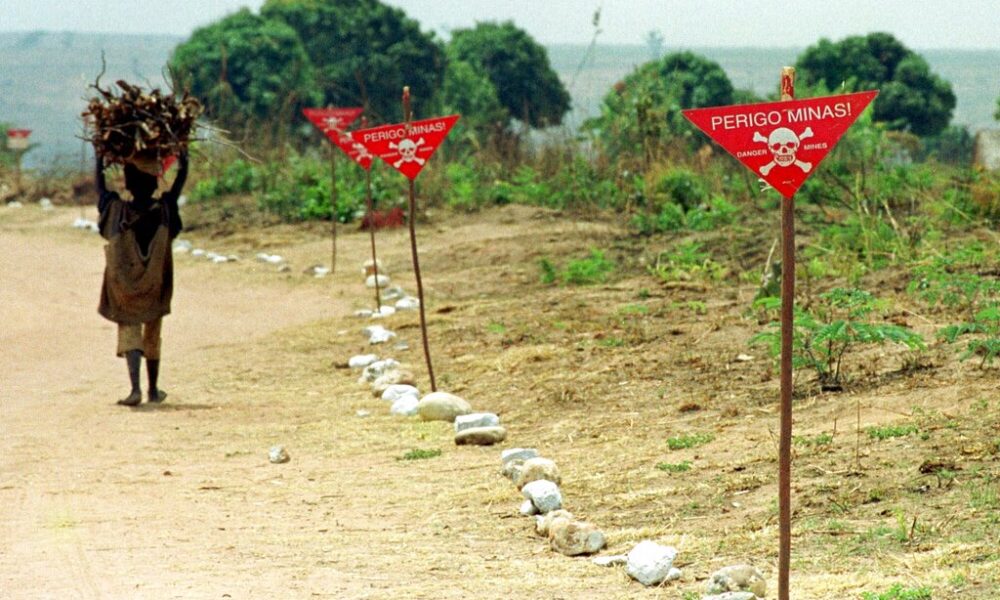Angola has reported major progress in clearing deadly land mines and unexploded ordnance (UXO) left behind from its 27-year civil war.
The development is improving safety, enabling farming, and unlocking opportunities for infrastructure and economic growth.
Brigadier General Leonardo Severino Sapalo, Director-General of the National Mine Action Agency, confirmed that provinces such as Benguela and Huambo are expected to be declared mine-free by the end of the year.
This milestone underscores Angola’s ongoing commitment to ridding the country of explosive remnants of war.
Sapalo made the remarks during a visit by a diplomatic delegation to demining sites supported by the HALO Trust, a U.K.-based non-governmental organization that has removed over 120,000 land mines in Angola since 1994.
“The railway has been completely de-mined so that it can be rehabilitated,” Sapalo said, referring to the Benguela Railway, a vital trade artery connecting Angola to the Democratic Republic of the Congo (DRC) and Zambia.
“The train runs naturally, but there are specific areas that have not been completely cleared of mines. The work is not at a standstill, but we need to energize it.”
Currently, about 975 minefields still require clearance, and $240 million is needed to finish the task, with costs estimated at $3.10 per square meter.
So far, the HALO Trust’s work along the Lobito Corridor has led to the destruction of 43,142 anti-personnel mines, 2,460 anti-tank mines, and over 235,000 other explosive items.
These efforts have opened up land for agriculture, housing, and economic development across several provinces.
Other international partners—including Belgium, Japan, Norway, and the United Kingdom—are working in tandem with Angola’s National Commission on Demining and the National Demining Institute to eliminate the country’s explosive legacy.
The minefields, many of them unmarked and unmapped, were laid during Angola’s brutal civil war, which lasted from 1975 until 2002.
According to the United Nations, up to 15,000 civilians are killed or injured by land mines in Angola each year, with many victims being children.
One such tragedy occurred in Moxico Province in 2023, when a 6-year-old girl was killed and six others were injured while playing with an unexploded device.
In another incident, three children were killed and six injured in Luanda Province in August 2024 after a hand grenade found in a trash can exploded.
“There is nobody in Angola who doesn’t know someone who got injured,” said Helena Kasongo of the Mines Advisory Group. “We need to stop this cycle for the good of our people and our nation.”
Demining efforts begin with surveys and vegetation clearing, followed by manual detection using metal detectors.
In some areas, specially trained rats are used to sniff out explosives without triggering them—offering an innovative, efficient, and cost-effective solution.
Although much of the early demining work focused on cities and regional capitals, current operations are concentrated in rural provinces such as Cuando Cubango, Cuanza Sul, Lunda Norte, Lunda Sul, and Moxico.
In addition to mine clearance, HALO Trust’s community outreach teams have been conducting risk education campaigns in vulnerable communities to help prevent further tragedies.
The Angolan Civil War
The Angolan Civil War was a 27-year conflict that began in 1975 and lasted until 2002. It started immediately after Angola gained independence from Portugal and was fought between two former anti-colonial guerrilla movements: the communist People’s Movement for the Liberation of Angola (MPLA) and the anti-communist National Union for the Total Independence of Angola (UNITA).
The war was sparked by a power struggle between the MPLA and UNITA, which had different roots in Angolan society and mutually incompatible leaderships.
A third movement, the National Front for the Liberation of Angola (FNLA), played a minor role in the conflict. The Front for the Liberation of the Enclave of Cabinda (FLEC) also fought for the independence of the province of Cabinda from Angola.
The MPLA was supported by Cuba, the Soviet Union, and other Eastern Bloc countries, including East Germany and Yugoslavia. UNITA was backed by the United States, South Africa, and Zaire (now the Democratic Republic of Congo).
Cuba played a decisive role in repelling the South African-UNITA advance, with 18,000 troops deployed in Angola.
The war resulted in a massive humanitarian crisis, with between 500,000 and 800,000 people killed, and over 1 million internally displaced.
Angola’s infrastructure, public administration, economy, and religious institutions were severely damaged.
The countryside remains littered with landmines, contributing to ongoing civilian casualties.
The MPLA ultimately achieved victory in 2002, with UNITA abandoning armed struggle and participating in electoral politics after the death of Jonas Savimbi, the leader of UNITA.
The conflict also had regional implications, becoming intertwined with the Second Congo War and the South African Border War.



